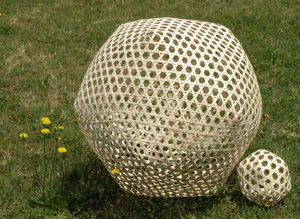Stacy Speyer recently completed a residency at the Exploratorium in San Francisco. For the Exploratorium’s traveling exhibition Geometry Playground, Speyer created an interactive exhibit of metal geometric forms known as polyhedra. Subsequently she began work on a book on this subject called Understanding Polyhedra. Speyer was trained as a textile artist (MFA California College of the Arts) and is known for her large scale open weave installations. She is the Studio Manager of the Textiles Department at California College of the Arts in Oakland.

Whirligig: What is the connection between your work in textiles and polyhedra?
Stacy: There is an underlying grid in the make up of all fabric woven on a loom, but the different weave structures possible on a loom can create a huge variety of patterns and kinds of fabrics. My favorite weave structure is called plain weave and it is the one I usually use for my loom woven artwork. It is the simplest structure and when done in the light open way I weave, the woven grid is revealed. Though it is visually layered by the colourful composition dyed into the threads. It depends on the viewer’s interest whether they are caught more by the details of colour or the organic woven.
 The start of all this polyhedra making, was a curiosity with a basketry technique, a hexagonal weave structure. It has three elements instead of the two in a basic grid that I am used to on the loom.
The start of all this polyhedra making, was a curiosity with a basketry technique, a hexagonal weave structure. It has three elements instead of the two in a basic grid that I am used to on the loom.
I liked the odd number of basic elements, one horizontal and two diagonals, that come together to make this regular structure. When all three elements meet, they make a small equilateral triangle and a set of two in three directions form the sides of a hexagon.
One year I worked out how to make the structure flat and the next year I tried making it into a basket. Then I wondered if I could close it off, making all the ends meet in some kind of spherical shape.
Spheres have always been a big part of my work but usually just seen as circles of dyed colour in the cloth or when the form the fabric is hung in an arc and column.
